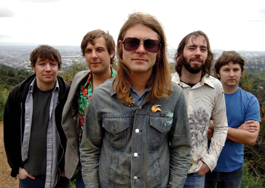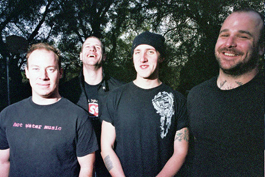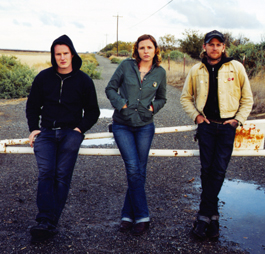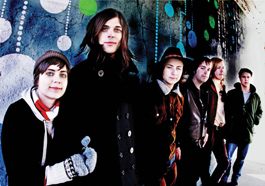home | metro santa cruz index | features | santa cruz | feature story

CELESTUIAL EVENTS Comets on Fire emerged from the Big Bang festivals with a Sub Pop contract. At lower right, festival organizer Oliver Brown, wise man of the Santa Cruz scene.
Sound Garden
Remembering 10 years of Santa Cruz underground music
By Paul M. Davis
PUTTING a retrospective of the Santa Cruz music scene into print is probably asking for trouble. After accepting this assignment, I posted a one-line status update to Facebook: "writing a roundup of Santa Cruz's most significant bands of the decade. Suggestions?" It didn't take long for the responses to start coming in. "There have been significant Santa Cruz bands since Camper Van Beethoven?" wrote one local, illustrating the foolhardiness of trying to present a single overview of a decade of Santa Cruz music. For every resident who thinks the local music scene ended in the early '80s when CVB signed to a major and left town, there's a grubby teenager in a Soquel garage blasting through two-minute punk songs who has never heard of David Lowery.
Ultimately, the terms "Santa Cruz music scene" and "Santa Cruz music community" are only convenient shorthand: there are many local scenes and communities. They only occasionally overlap, if ever. But for as long as I've been following Santa Cruz underground music, the concerns have remained the same. The local scene, often tethered to the four-year UCSC academic cycle, is far too transitory; bands are too flighty and don't stick around long. There aren't enough places to play. The relative geographic isolation makes touring difficult. As someone who played music in the town for the better part of the decade before leaving for Chicago in 2006, I've heard these sentiments many a time. They're echoed to this day by friends who continue to keep me apprised of what's going on in my old town.
I'd like to celebrate, from my limited perspective as a player in some of those communities and an outside observer of others, the bands of the past decade that have overcome the challenges facing all Santa Cruz musicians—both the ones who have remained in town to become local institutions and those who have left to achieve wider notoriety.

IT'S GOOD TO BE KING: The Lonely Kings went from selling out the Catalyst in the early 2000s to touring Europe.
Big Bang
If this decade was the one in which indie rock broke, Santa Cruz was a bellwether. Linked by an underground telegraph that spiritually connected the local scene with those in Olympia, Wash., and Portland, Ore., Santa Cruz in the years 2000–2003 was a stunningly fertile place for indie rock.
The scene's wise benefactor was local ukulele star Oliver Brown, the Jonathan Richman–indebted schoolteacher/songwriter who for four years starting in 2000 curated the 11-night annual Big Bang festival. Many of the bands on the Big Bang lineups have been forgotten, but viewed in aggregate, it's stunning how accurately the festival predicted the decade of music to come. Out-of-town acts such as Sacramento-based !!! and Portland's The Blow, destined to become certifiable underground stars within a few years, were complete unknowns when they played the Big Bang. These acts opened for local bands whose vision appears eerily prescient in retrospect—bands like the Lowdown, a three-piece specializing in an unholy racket that resembled Devo on a bender of bad meth and blown-out amps, a corrosive mixture of noise, speed and technology that predicted bands such as the Locust.
Much the promise of the scene was embodied in the band that seemed most likely to blow up at the time: the sweetly sci-fi, Pixies-referencing four-piece Sin in Space. Led by singer/guitarist Cassidy Meijer and anchored by drummer Greg Braithwaite, an able hand who has turned up in numerous bands during the decade (including the immortal Huxtables), the band enjoyed an incredible amount of promise and label interest. If an observer was to guess which Santa Cruz indie band would break through to greater things in 2000 or '02, Sin in Space would have been it. Instead, that band was fellow Big Bang fixture Comets on Fire, the acid-rock-riffing four-piece that dominated many a house party for the first third of the decade before signing to Sub Pop Records and becoming the toast of Pitchfork and the indie-rock intelligentsia.
Reign of Lorelei
There was a ton of other activity in Santa Cruz underground music in the early decade, as well. While the UC art kids were helping define the blueprint for '00s indie rock, the local punk scene—comprised of true Santa Cruz locals, as they would surely remind you—were growing restless. Diversion, a Soquel trio started by three preteen punks in the late '90s, had morphed from a precociously smart-ass hardcore group into something more resembling progressive rock. Just as the emo craze was hitting the national spotlight, it was cresting in Santa Cruz, with locally anointed emo demigods like the Lonely Kings, Jetlag and Time Spent Driving selling out the Catalyst.
As that generation of local punk bands moved on, a new shoot emerged in 2004, nurtured by one of the heavyweights of 1990s Santa Cruz music. Roughly organized beneath the banner of Lorelei Records, an independent label founded by former Fury 66 singer Joe Clements, the new punks avoided the polished emo sound that had dominated Santa Cruz during the late '90s and taken over MTV by 2003. Instead, the bands harkened back to various strains of '80s and early-'90s American punk rock. Clements headed up two of the most high-profile if short-lived bands, Audiocrush and Crucial Unicorn, while Here Kitty Kitty mashed riot grrl snarl to Ramones-esque razorblade bubblegum. The most durable of the new guard, immortalized in Lorelei's 2005 compilation Bombs Over Santa Cruz, was Los Dryheavers. A five-piece Mexican punk outfit from Watsonville, Los Dryheavers echoed the chunky fuzz of '80s American punk rock while throwing in an extra-heavy helping of Guns N' Roses–quoting riffage. With three albums under their belt and a number of tours and Warped Tour slots, the Dryheavers have effectively placed Watsonville on the Santa Cruz underground map.

AND THEN THERE WERE THREE: The Devil Makes Three's unholy union of bluegrass and punk was unheard of when they started playing around town in 2002.
The Folks Are in Town
It's impossible to talk about Santa Cruz music in this decade without mentioning The Devil Makes Three. Admittedly, I'm a biased observer—I lived with the trio, played in other, far less notable, bands with them and even poisoned the lead singer with undercooked chicken, an event chronicled in a song on the band's latest album. But for the middle years of the decade the band clearly dominated the local scene, bridging the gaps between art-rock hipsters, body-building Eastside locals and august KPIG listeners. The Devil Makes Three were far from the first to do what they did—lash bluegrass and string-band music to punk-rock populism—but they were one of the first to do it in Santa Cruz and possibly the first to do it so well. Today, the band tours the nation and gets attention in national publications, but from 2002 to 2006 they were the local band to beat, packing basements and the Catalyst with ease and drawing national attention to a lively local scene that has always deserved more attention from the outside world. This era was probably my most active in the local music community. I played with the local cowpunk outfit Mule Train and organizing two compilations, Someday Coming Down and Someday Coming Round, that documented the town's fascination with viewing American folk traditions through a punk- or indie-tinted lens. It's a spirit that can be found in a wide variety of local acts, from the born-and-raised rockabilly partisans the Chop Tops to the unholy howl of Steven Griswold's disheveled country ballads.
The entire town seemed to be in a folkier mood during the midsection of the decade. As a large number of bands tweaked various forms of American folk music, artists such as Whysp, Emily Jane White and Ben Chasny were unearthing a more meditative form of acoustic music. Carrying a torch for the nearly-forgotten '60s psych-folk of Vashti Bunyan and Bert Jansch, this trio of local artists played an important role in defining the then-nascent freak-folk scene ignited in San Francisco and L.A. by Devendra Banhardt. Unassuming and quiet, former Streetlight employee Chasny and White remained on the fringes of the local music community, and the work they recorded in town—Chasny as Six Organs of Admittance and White with the Diamond Star Halos—can be best appreciated in retrospect, long after they left and become critical favorites the world over.
Beachcombers
For sheer visibility and impact on the outside world, The Devil Makes Three's success was rivaled by the Expendables, a four-piece that dominated the stage like an 800-pound gorilla. Cribbing notes from Sublime and the Long Beach Dub All-Stars, the Expendables whipped up reggae, dub and metal into an amalgam that typified the sleepy beach-town vibe that draws so many people to Santa Cruz. Since the day in 2002 when the Expendables—Adam Patterson, Geoff Weers, Raul Bianchi and Ryan DeMars—were crowned the winners of Your Music Magazine's first Battle of the Bands, the quartet has been on an upward trajectory, first dominating Santa Cruz before becoming a dependable touring act and even turning up on the soundtrack of Guitar Hero World Tour—the surest indicator of having made it by the end of the decade.
If the Expendables typified one side of the town's beach-town vibe, SambaDá exemplified its musically diverse, ebullient, polyglot complement. Formed in 1998 by local Brazilian expatriates Papiba Godinho and Dandha da Hora, the band has proven to be one of the town's most dependable and venerable acts, specializing in an intricately percussive sound that spans the Americas in its influences. By 2007, the band was recording with a Grammy-nominated producer (on the record Salve a Bahia), and serving as goodwill ambassadors to the world, of not only the multitude of cultures the band encompassed, but of a uniquely Santa Cruz sound that has inspired a generation of local world music artists.

RISING STAR: Sleepy Sun will get back to you when they return from Italy.
Decade's End
Yet as the Expendables and SambaDá came to embody Santa Cruz's laid-back beach-town vibe, a crew of snot-nosed art punks sought to expose its id. On the heels of the promising yet short-lived Gross Gang, the New Thrill Parade dominated the town's underground art scene in '05 and '06, lurching through Birthday Party–indebted noise-rock with the weight of a hundred hippies on bad tabs of acid. It was a restless time all around, as city noise ordinances grew tighter and the underground house show scene all but disappeared. The response of bands such as the New Thrill Parade and the celestial noise-rock band Residual Echoes was to turn it up even louder, tossing defiant cacophonies back at a City Council that preferred its local art scene to be safe for tourist consumption.
As the latter third of the decade rolled around, the underground's twin obsessions of noise rock and psychedelia united. Indulging in opulent acid-rock excess, Sleepy Sun and the Vox Jaguars became the new standard-bearers for the local underground community. Both bands signed to indie labels in '08 and have garnered the attention of the global psych-rock underground, once a niche movement of '60s revivalists that has become legion in the globally connected age of social networking. On the sleazier end of things is the Groggs, dirty-humping garage-rock sleazebags who strip all the art from the art-rock in favor of a primeval yawp.
Emboldened by the success of The Devil Makes Three, indie- and punk-inflected folk music has become something of an institution of its own in town: witness the success of Birds Fled From Me, featuring Rachel Williams of Sleepy Sun, or the success of last year's The Sounds of San Lorenzo compilation, organized by JJ McCabe of Mylo Jenkins and Tether Horse and Dustin St. Wright. A two-disc sampler split between local rock and folk acts, the compilation remains a striking taste of what's to come in Santa Cruz music while also being perhaps one of the most exhaustive single-project overviews of the diversity of the local community.
A decade later, few of the players are the same. Yet the local underground music community remains vibrant, ever vigilant in the face of too few venues, UC student turnover, the high cost of living and the other difficulties facing musicians in Santa Cruz. The new guard, headed up by the likes of Fire Whiskey, Sourgrass, the Spurts and countless others, enter the new decade unbowed by the eternal challenges. You'd be hard-pressed to find a more active, supportive and diverse set of local music communities incubating such a wide array of bands and genres. As the world grows smaller and Santa Cruz's renown slowly grows, some of these bands are destined to be the new decade's next big thing.
Thanks to the following for their suggestions, feedback, criticisms and much clearer memories, transmitted via the wonder of the social web: The Santa Cruz Underground Music wiki, Siobahn Barry, Oliver Brown, Hiram Coffee, Mykle Hoban, JJ McCabe, Nick Meo, Pete Saporito and Hiya Swanhuyser.
Send a letter to the editor about this story.
|
|
|
|
|
|